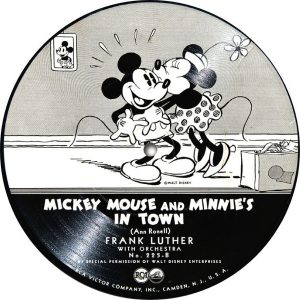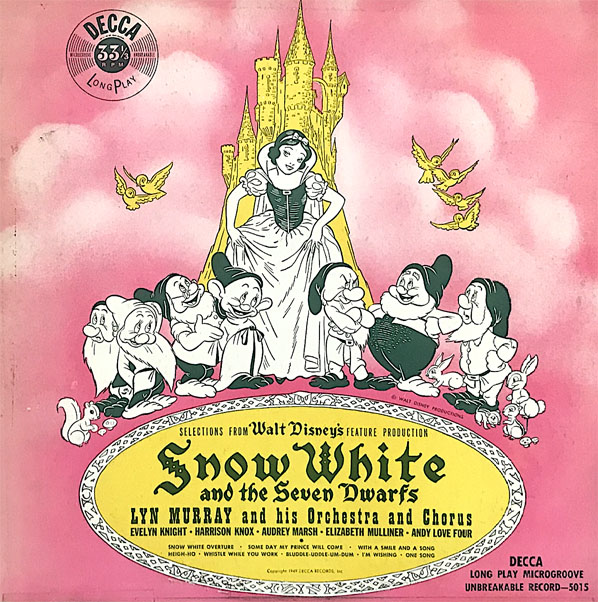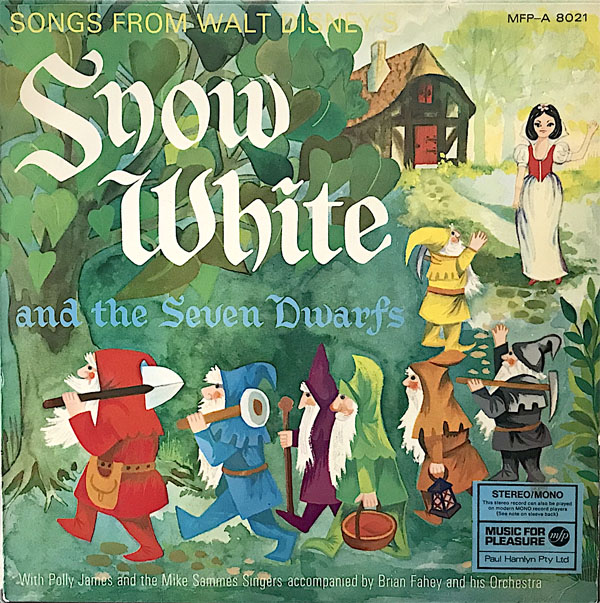Saluting Snow White and the Seven Dwarfs, released nationwide in February 1938, here’s the first of two looks at adaptations on records.
 Snow White and the Seven Dwarfs premiered in 1937, but it did not go into wide release until early February 1938. An eager public, already excited by word-of-mouth and publicity of this game-changing phenomenon, flocked to theaters. Snow White quickly became the highest-grossing movie of its time with an ongoing popularity and business impact on the level of Star Wars. It’s still near the top of the list of all-time biggest hits, along with several prestigious “Best Of” lists. Its impact on the entertainment industry cannot be underestimated.
Snow White and the Seven Dwarfs premiered in 1937, but it did not go into wide release until early February 1938. An eager public, already excited by word-of-mouth and publicity of this game-changing phenomenon, flocked to theaters. Snow White quickly became the highest-grossing movie of its time with an ongoing popularity and business impact on the level of Star Wars. It’s still near the top of the list of all-time biggest hits, along with several prestigious “Best Of” lists. Its impact on the entertainment industry cannot be underestimated.
The buzz for the movie was accompanied by the hit status of its musical score. “Heigh-Ho,” “Whistle While You Work,” “Someday My Prince Will Come,” “One Song” and “With a Smile and a Song” became standards, with novelty status for “A Silly Song” and “Bluddle-Um-Dum-Dum (The Washing Song).” Countless single records and compilations featured these songs by major recording stars as well as “cover” artists on various budget and children’s labels. Our colleague James Parten has already created a voluminous account of the earliest records in a number of Needle Drop Notes posts.
Here at Animation Spin, we’ve looked at the Snow White soundtrack album on RCA Victor and Disney’s house labels as well as the Radio City Music Hall cast version and, most recently, Tutti Camarata’s interpretation of the score.
Lots of albums included songs from Snow White combined with additional Disney or other songs. This two-part edition of Spin examines an eclectic mix of albums that feature Snow White exclusively, particularly the score.

1938: Decca Presents the Complete Score of Walt Disney’s Snow White and the Seven Dwarfs Especially Adapted for Children from the Walt Disney Production – Frank Luther (Decca)
 In 1933, singer/songwriter Frank Luther appeared on what is believed to be the first Disney-related records on RCA Victor: “Mickey Mouse and Minnie’s in Town,” “In a Silly Symphony,” “Lullaby Land of Nowhere” and “Who’s Afraid of the Big Bad Wolf.” He became one of the most prolific recording artists for children in the mid-20th century, Decca being his primary label. Decca and its subsidiary label, Vocalion, reissued most of his records on LP. More about the Disney records and Luther are in this Needle Drop Notes post.
In 1933, singer/songwriter Frank Luther appeared on what is believed to be the first Disney-related records on RCA Victor: “Mickey Mouse and Minnie’s in Town,” “In a Silly Symphony,” “Lullaby Land of Nowhere” and “Who’s Afraid of the Big Bad Wolf.” He became one of the most prolific recording artists for children in the mid-20th century, Decca being his primary label. Decca and its subsidiary label, Vocalion, reissued most of his records on LP. More about the Disney records and Luther are in this Needle Drop Notes post.
Luther recorded what is perhaps the earliest cover album of the Snow White film score with his wife, Zora Layman as Snow White and The Clubmen as the Seven Dwarfs. In addition to signing and narrating, Luther often chose to weave the elements together into little scenarios with his own additional rhymes, lyrics, and story material. On the Snow White album, he is the prince as well as the narrator, with some solos becoming his duets with Layman.
Decca’s 78 rpm album was reissued on a Vocalion LP with no mention of Disney on the cover, with Luther’s 1936 version of Lewis Carroll’s Alice in Wonderland on side two. His version of Alice resurfaced when Ginger Rogers played the role for Decca, which is discussed in this Animation Spin.

1944: Selections from Walt Disney’s Snow White and the Seven Dwarfs – Lyn Murray (and His Orchestra & Chorus (Decca)
Emmy winner Lyn Murray was one of Hollywood and Broadway’s busiest composers, conductors, and vocal arrangers. His animation credits include Walt Disney’s Cinderella, George Pals’ tom thumb, and the UPA series The Gerald McBoing-Boing Show and The Famous Adventures of Mr. Magoo.
For the Snow White album, Murray called upon many of the finest Hollywood studio vocalists including Evelyn Knight, Audrey Marsh, Harrison Knox, and the Andy Love Four. Of particular note is Elizabeth Mulliner, also known as Betty Mulliner and Betty Luboff (during her marriage to musical director Norman Luboff. On Camarata’s spectacular classic Disneyland album, Music from Alice in Wonderland with Darlene Gillespie, Mulliner-Luboff can be heard singing several short solo lines. She is also prominent in the early Mickey Mouse Club records.
Murray presents the Snow White score on a grand scale with a full orchestra. The arrangements are alternately lush and playful, with inventive touches like interpolating “Listen to the Mockingbird” and “The Whistler and His Dog” into “Whistle While You Work.” The 78 rpm album was reissued by Decca on a ten-inch “Deccalite”

1966: Songs from Walt Disney’s Snow White and the Seven Dwarfs (MFP Music for Pleasure)
A year before The Mike Sammes Singers began their long association with Tutti Camarata and Disneyland/Buena Vista Records, they recorded this album and other songs from Disney films. Brian Fahey, who was also involved in the Disney recordings, created the orchestrations.
And lavish these orchestrations are. British records were still able to record albums with larger orchestras far into the 1960s, even for children’s and low-budget albums. American record companies had discovered this and frequently recorded albums in Europe.
Snow White’s songs are heard in Polly James’s bell-clear soprano. It’s almost like hearing Julie Andrews singing the score (but no coincidence, James also sang on a Mary Poppins album for MFP). A stage and screen actor-singer, James appeared with Dame Judi Dench in The Merchant of Venice, as well as numerous series including the popular Coronation Street.
The Mike Sammes Singers would continue to be one of the world’s top vocal groups, recording with Frank Sinatra, Tom Jones, and The Beatles, and many more, as well as themes for Gerry Anderson Supermarionation series.
Look for part two, and four more albums, in the next Animation Spin.


 GREG EHRBAR is a freelance writer/producer for television, advertising, books, theme parks and stage. Greg has worked on content for such studios as Disney, Warner and Universal, with some of Hollywood’s biggest stars. His numerous books include Mouse Tracks: The Story of Walt Disney Records (with Tim Hollis). Visit
GREG EHRBAR is a freelance writer/producer for television, advertising, books, theme parks and stage. Greg has worked on content for such studios as Disney, Warner and Universal, with some of Hollywood’s biggest stars. His numerous books include Mouse Tracks: The Story of Walt Disney Records (with Tim Hollis). Visit 





















































All three of these recordings have elements of orchestration in common, for example pizzicato strings and mallet percussion in the up-tempo numbers, and divisi strings and harp (piano in the Frank Luther version) in the lyrical tunes. Not surprising that the same tunes would inspire similar approaches from different arrangers.
Luther’s background in country music is apparent here, and I was amused by his inclusion of an ocarina, a fad instrument of the late 1930s. I like the Murray recording best; his orchestrations have a lot of subtlety, for example in his use of solo strings and muted brass, and his complex countermelodies and adventurous harmonies show great ingenuity. He really makes the Snow White songs his own.
Wow! What a treat! Three full albums! And each reflective of a different era in terms of music and pop culture! In 1938, the songs were a novelty–fresh and ripe for interpretation. By 1944, they were pop standards providing a needed respite from the ravages of war–embracing both jazzy and operatic elements. And by 1966, they had become firmly established as iconic tunes associated with Disneyland, the TV show “Walt Disney’s Wonderful World of Color,” and as popular music in their own right (I never got the feeling of vintage Disney songs as being passe or old hat at any time during the 60’s or 70’s–they were as vibrant and current as when first introduced–possibly due to the ongoing reissues of the animated features).
The Frank Luther album offers some very interesting twists, particularly in the first encounter between Snow White and the Prince–with the Dwarfs present! I notice that the story as presented doesn’t closely follow the movie, but is more tailored to go with the audio versions of the songs. This makes for a very interesting listen. And using “Heigh Ho” as sung by the Dwarfs for the finale puts me in mind of the ending of the “Enchanted Tiki Room” with similarly re-purposed lyrics for the purpose of saying goodbye to the audience.
The Lyn Murray album features yet again more fresh re-interpretations. The rendition of “I’m Wishing” (which if I’m not mistaken was presented twice) is presented in an operatic style which causes me to speculate on what a picnic Jeannette MacDonald and Nelson Eddy might have made of this score. It would also be nice to hear an Irene Dunne take on this music. But back to the Murray album–I observe that they chose to end it with “One Song,” another interesting choice at variance with the use of a reprise of “Some Day My Prince Will Come” as in the film. I would like to know who the vocalist was on “One Song.”
And the Mike Sammes Singers album is another audio treat. Your comparison of Polly James to Julie Andrews is spot-on. In fact, on “With a Smile and a Song” and “Someday My Prince” she almost sounds exactly like Julie–certainly interpreting the songs the way Julie might have done, with similar vocal inflections. I would like to know who the “One Song” singer is on this album, as well. Among the Dwarfs–each given individual personalities in this as in the other recordings–I thought I detected the voice of Thurl Ravenscroft. I could be mistaken, because I live in an apartment and have to keep the volume at a low level, but it sounded like him. And once again, “Someday My Prince” is replaced as the finale, this time by “With a Smile and a Song.”
Certainly the Mike Sammes Singers made themselves almost synonymous with Disney during that next decade or so–they seemed especially to “own’ their interpretations of Disney music, particularly in my mind with the Sherman Brothers scores. In the music video, I recognized Mike Sammes as the singer in the middle–his voice is very distinctive. I didn’t notice him soloing in the Snow White album–unless he disguised his voice as one of the Dwarfs.
Also note how the first and third album covers feature non-Disney versions of the characters, while the middle one uses some of the earlier renderings of Snow White and the Dwarfs.
Overall, a great posting! I look forward to Part Two!
Tony Peters sang for the Prince, but I have no current access to information about him. He is not the same person who designed early Rankin/Bass films.
Tony Peters also sings on this Youtube video a song which he also seems to have written with composer Trevor H. Stanford! https://www.youtube.com/watch?v=_7euiP-v1Lc
Maybe you can answer a question about Decca’s subsidiary label that’s always puzzled me. What’s the correct pronunciation of “Vocalion”? Is it pronounced “Voc Alien” or “Vocal ion”? I can’t remember ever hearing anyone say it out loud.
Hi Paul, my father was the Louisiana-Mississippi representative for Decca Records from 1956 until 1971. I recall him pronouncing their lower-price reissue label Vocalion as “Vo-CAL-leon”.
I have always known it as “vo-CAY-le-in,” which apparently is the British way, but there are several ways described online.
Hard to find info on the Prince who sings oppsoite Polly James … this beautiful song with the Tony Osborne orchestra: Tony Peters! https://www.google.fr/search?q=alone+again+tony+peters&source=lnms&sa=X&ved=2ahUKEwjzxOb6vtP9AhXaRaQEHZzaDFk4HhD8BSgAegQIChAC&biw=1366&bih=657&dpr=1#fpstate=ive&vld=cid:e08ba246,vid:_7euiP-v1Lc